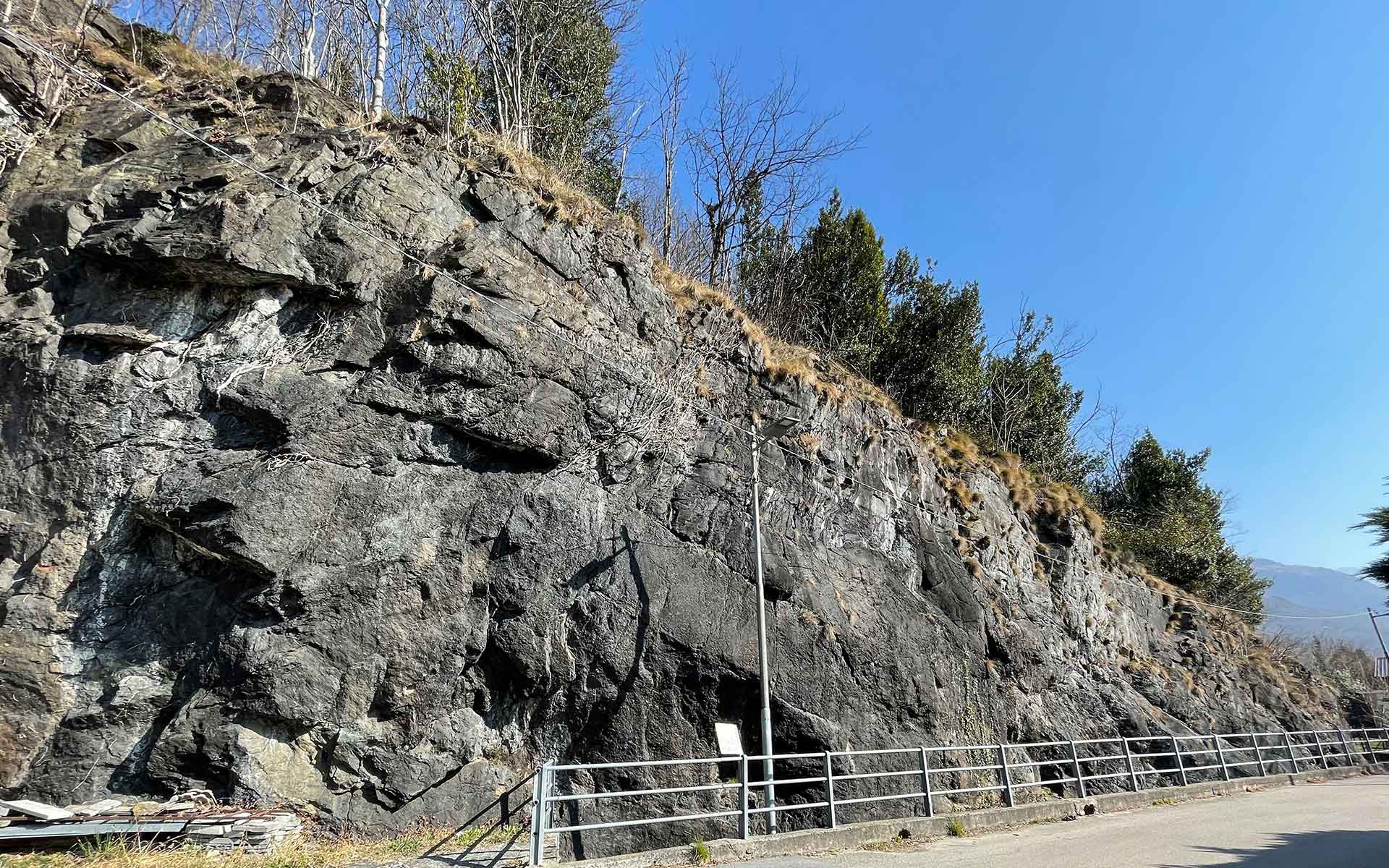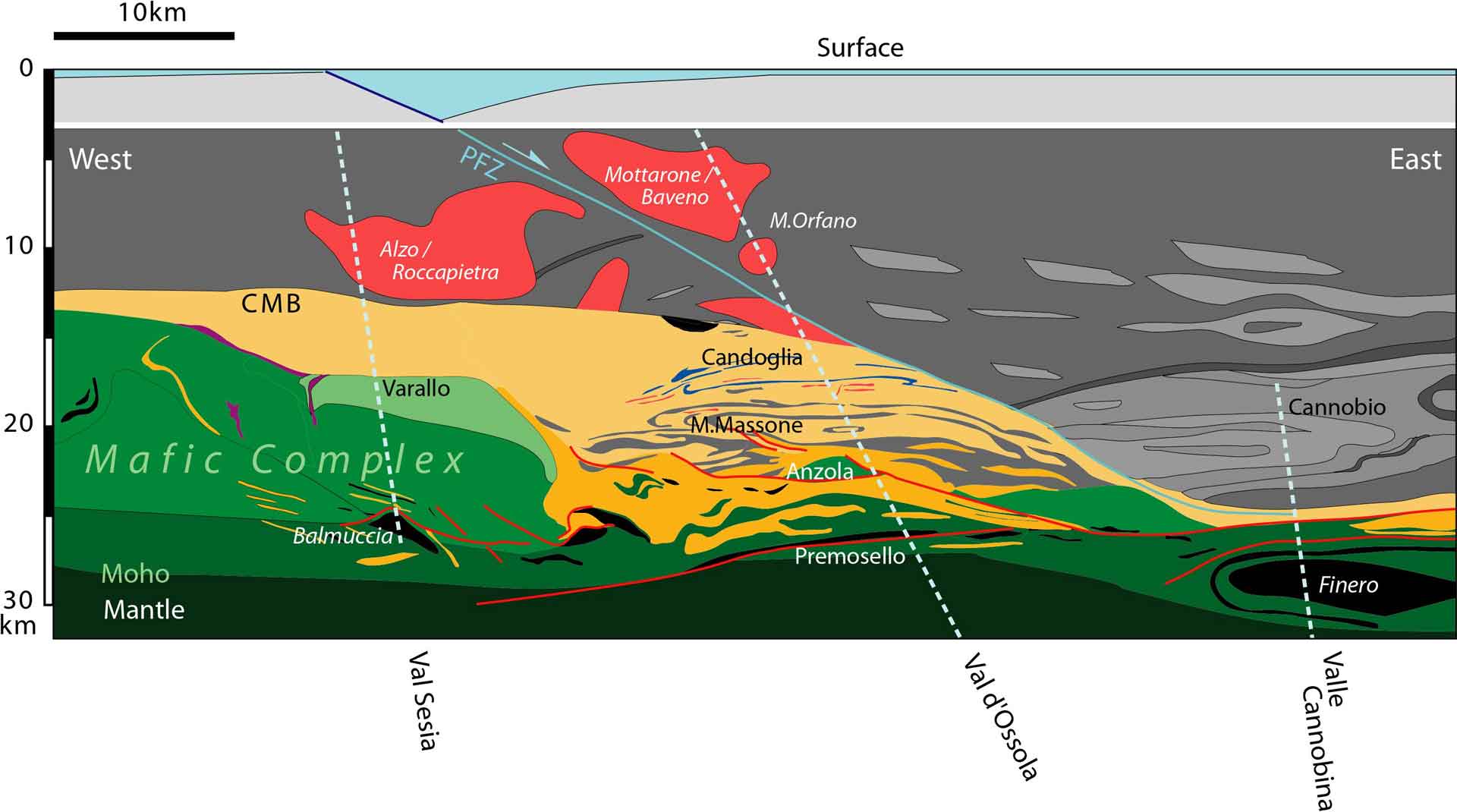
The Premosello outcrop.
Geological Period
Permian
Main geological interest
Igneous and Metamorphic petrology
Tectonics
Location
Premosello, Piemonte Region, Italy
46°00’20”N, 008°19’16”E
The Premosello outcrop.
A classical Moho outcrop in Europe showing the contact between continental mantle and lower continental crust.
The mantle-crust transition is exposed in a few sections in the world, and most of these involve oceanic crust. The Premosello outcrop displays the boundary between mantle and lower continental crust, which normally lies at a depth of 30-35 kilometers or more below collisional chains. For more than 40 years this area has served scientists as an unprecedented crustal reference section in which geophysical observations and physical processes may be interpreted in the context of geology that is observable on the ground. Since 2013 the site is included in the UNESCO Sesia – Val Grande Geopark.
- Geological description
The outcrop shows the contact between lithospheric mantle rocks and the lower continental crust. The mantle is represented by a serpentinized peridotite, in the lower part of the outcrop; the lower crust is represented by a mafic granulite, part of the Mafic Complex of the Ivrea-Verbano Zone, in the upper part. Serpentinization results from hydration of olivine to serpentine minerals. Mafic granulite consists of prevailing pyroxene and plagioclase and may be described as well as a gabbro.
The contact surface represents the Mohorovicic discontinuity, marking the transition from upper mantle to lower crust. The Ivrea-Verbano Zone mainly consists of a metamorphosed volcano-sedimentary sequence, referred to as the Kinzigite Formation, and gabbroic to dioritic intrusive rocks, referred to as the Mafic Complex. Mantle peridotite lenses, tectonically interfingered with the metasedimentary rocks, occur in the northwestern part of the Ivrea-Verbano Zone, near the Canavese Line (Balmuccia in the Sesia valley and Finero in the Cannobina valley). At Premosello the Mohorovicic discontinuity appears to have been brought to surface through exhumation processes occured during the subsequent Alpine orogeny.
- Scientific research and tradition
The Ivrea-Verbano Zone is easily accessible (less than 100 km from Milano and 100 km from Turin) and has been intensively studied. The number of scientific papers referencing the Ivrea-Verbano Zone alone has increased exponentially since 1970 and now exceeds 2500.
- Reference
Boriani, A. and Rivalenti, G. (1984) ‘Crosta profonda e significato delle rocce basiche e ultrabasiche dell’Ivrea-Verbano in un secolo di studi’, in Cento anni di geologia Italiana, pp. 113–131.
Brack, P., Ulmer, P. and Schmid, S.M. (2010) ‘A crustal-scale magmatic system from the Earth’s mantle to the Permian surface: Field trip to the area of lower Valsesia and Val d’Ossola (Massiccio dei Laghi, Southern Alps, Northern Italy)’, Swiss Bulletin für angewandte Geologie, 15(2), pp. 3–21.
Quick, J.E., Sinigoi, S. and Mayer, A. (1994) ‘Emplacement dynamics of a large mafic intrusion in the lower crust, Ivrea-Verbano Zone, northern Italy’, Journal of Geophysical Research: Solid Earth, 99(B11), pp. 21559–21573. Available at: https://doi.org/10.1029/94JB00113.
Quick, J.E., Sinigoi, S. and Mayer, A. (1995) ‘Emplacement of mantle peridotite in the lower continental crust, Ivrea-Verbano zone, northwest Italy’, Geology, 23(8), pp. 739–742. Available at: https://doi.org/10.1130/0091-7613(1995)023<0739:EOMPIT>2.3.CO;2.
Schmid, S.M. (1993) ‘Ivrea Zone and Adjacent Southern Alpine Basement’, in J.F. von Raumer and F. Neubauer (eds) Pre-Mesozoic Geology in the Alps. Berlin, Heidelberg: Springer, pp. 567–583. Available at: https://doi.org/10.1007/978-3-642-84640-3_33.
- Author(s)
Paolo Falletti.
ARPA Piemonte, Biella, Italy.


